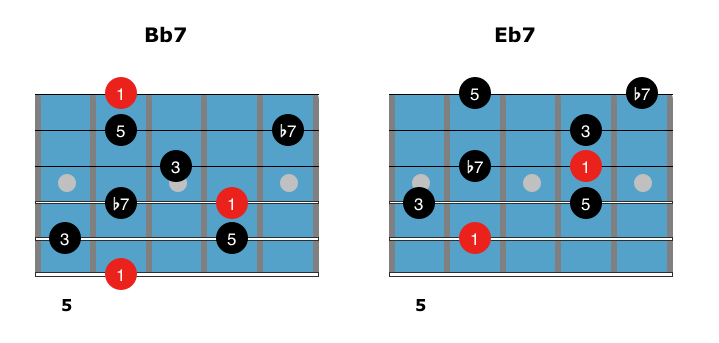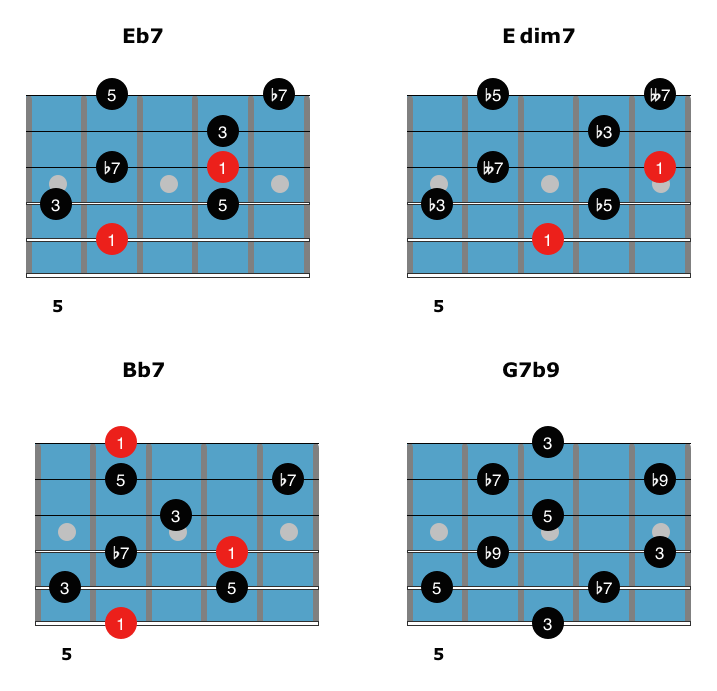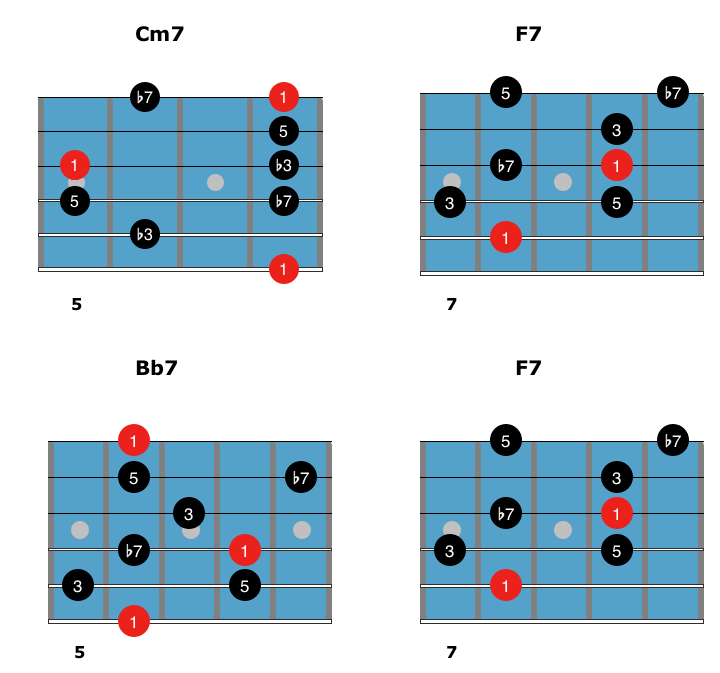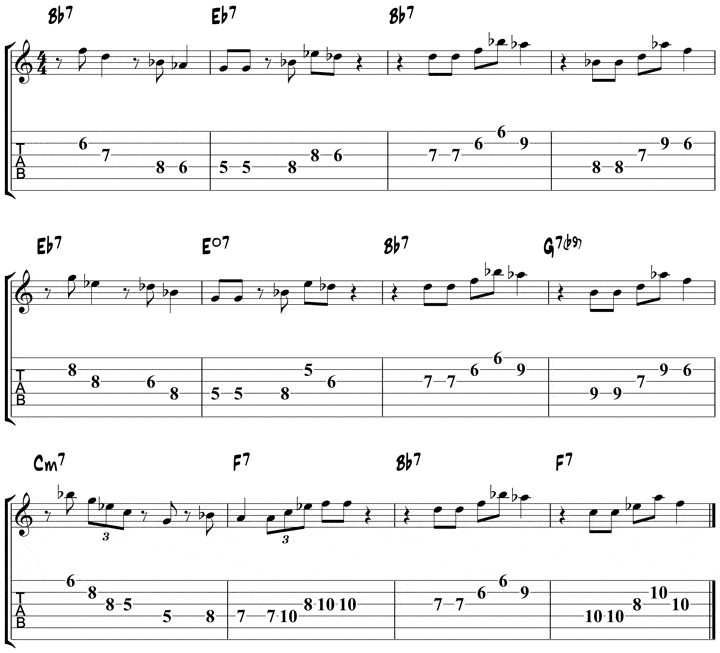When learning how to play arpeggios over the jazz blues chord progression, or any tune for that matter, the easiest approach you can take in is to learn the arpeggio shapes within one position on the fretboard.
This means that you’ll be able to play arpeggios over each chord in the progression without moving your hand up or down the fretboard, or with a minimal movement up and down the fretboard.
By doing so, you will be able to outline each chord in your solos, nailing the chord tones in your improvised lines, while making it easy on your hands at the same time, as you won’t be making any unnecessary leaps or shifts in your playing.
The following lesson provides you an outline of how to play arpeggios over a Bb jazz blues progression in one position, how to practice these arpeggios in your studies, and a sample study written out to provide you an example of these shapes in action.
Bb Jazz Blues Arpeggios – Bars 1-4
Here are the shapes you can learn to play over bars 1 to 4 in a Bb jazz blues, starting with the Bb7 arpeggio on the 6th string and moving to the Eb7 arpeggio on the 5th string.
By mixing these string sets, you will be able to practice, learn, and later solo with these arpeggio shapes over a Bb jazz blues progression without moving your hand up or down the fretboard.
Listen & Play Along

Bb Jazz Blues Arpeggios – Bars 5-8
Moving on, here are the four arpeggios for bars 5 to 8 in a Bb jazz blues, all played without moving your hand on the fretboard.
You will notice that the last arpeggio (G7b9) doesn’t have a root note within this shape. This is because you are using a Bdim7 arpeggio over the G7b9 chord. This is a very common approach to using arpeggios over 7b9 chords, playing a dim7 arpeggio from the 3rd of the underlying chord in order to highlight the 3-5-b7-b9 intervals over that underlying chord.
To get a 7b9 sound, play a diminished arpeggio starting on the 3rd of the dominant chord.
Example: play a Bdim7 arpeggio over G7
If this is a new concept for you, try putting on a G7b9 backing track and solo over that single chord using the Bdim7 arpeggio in order to get this rootless arpeggio sound under your fingers and into your ears before taking it to the full jazz blues chord progression.
Listen & Play Along

Bb Jazz Blues Arpeggios – Bars 9-12
In the final four bars of the Bb jazz blues progression, you will move your hand a few frets to play the F7 arpeggio, adding a bit of a shift up the neck by a few frets in order to use the same shape for F7 as you did for the Eb7 arpeggio in this exercise.
Sometimes you will need to make a decision between using a new fingering for an arpeggio, such as F7 in this blues progression, or moving around the neck a few frets in order to use the same shape as you did earlier in the tune.
There is no right or wrong way to approach this, so try both methods out and see which one works better for you in your studies.
Listen & Play Along

Easy Jazz Blues Arpeggios – Directional Exercises
Now that you have the Bb jazz blues arpeggio shapes under your fingers in one position, you can work on a few exercises in order to memorize these shapes and work on transitioning between each shape over the 12-bar progression.
In the following exercises, you will see a single direction applied to each arpeggio, written out over the first four bars of the Bb jazz blues in the examples.
Once you have the first four bars down, continue each directional approach to the arpeggio over the whole 12-bar progression in order to take it further in your studies.
To begin, here are the first four bars to a Bb jazz blues progression with the arpeggios all ascending through the chords.
Listen & Play Along

Moving on, here are the same four bars, but this time all of the arpeggios are descending over the changes.
Listen & Play Along

Lastly, you can also alternate one arpeggio up and one arpeggio down and you practice these shapes over the jazz blues chord changes.
Listen & Play Along

Bb Jazz Blues Arpeggio Study
To finish your intro to in-position jazz blues arpeggios, here is a sample study written out over the Bb jazz blues chord progression. Start by learning to play the study as written, memorizing it if possible, in order to get an idea of how you can apply these arpeggio shapes to a musical situation.
From there, try writing out an arpeggio study of your own, using the shapes in this lesson, as well as putting on a Bb jazz blues backing track and soloing over those changes using only the arpeggios you learned in this article.
Listen & Play Along



Exelente enfoque
Hi Dirk, This arpeggio study has been a huge help to my playing. I am also having fun with the Bob Dylan tune. I totally appreciate your web site. It is so well done….Thank you
What’s the recommended fingering on bar 9 over the Cmin7? Rolling with the 4th finger is quite a challenge! Any suggestions on practicing to build up speed for that? The staccato nature of this solo is a little stiff sounding but still a great exercise in jazz blues soloing..
Hey, play 1-3-3-1, on those first four notes, will help make it quicker. Cheers.
works good
Very good lessons for us beginners, i hope i will found my way.Thanks.
awesome
I’m thankful for this lesson. As other friends suggested, the given exercises are too fast for begginers. Thanks
Thanks man!!
Hi, thanks again.
Can I make a suggestion? Please make the ‘loop’ button on the Listen & Play player red or green when clicked on! I reckon this would be better than grey and slightly darker grey.
Thanks. Just what I needed.
Thanks
Another great lesson, but the examples are a little too fast for some of
us beginners.
Very Nice lesson
Very useful.
Nicely done. Always good to build from the ground up. Looking forward to “The Easy Guide….”
very good lesson but the “listen and play” is too fast for beginners. Is it possible to add 2″ listen and play” : one slow tempo and the other like it is now?
awesome lesson
Thanks again for the lessons.E